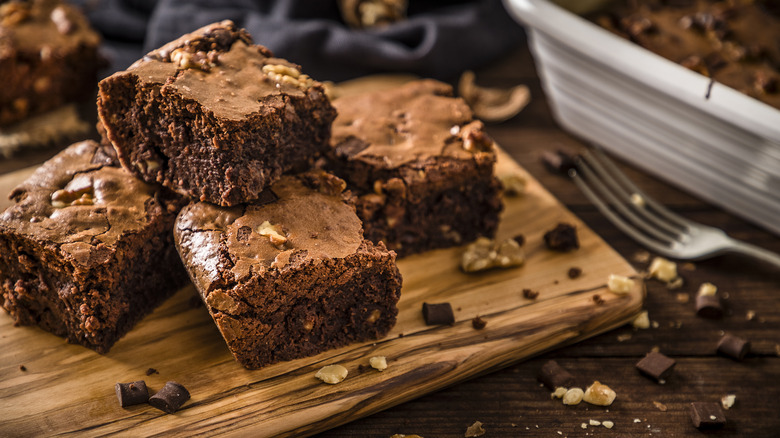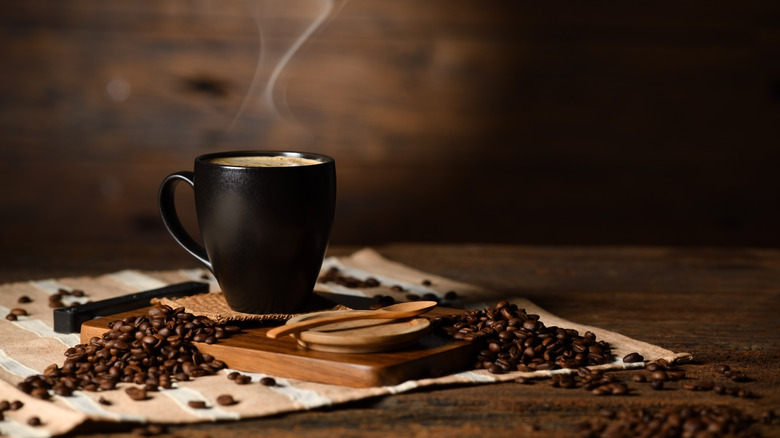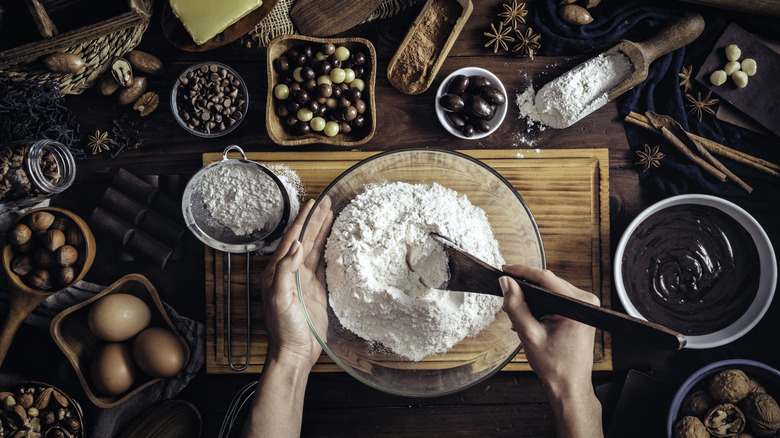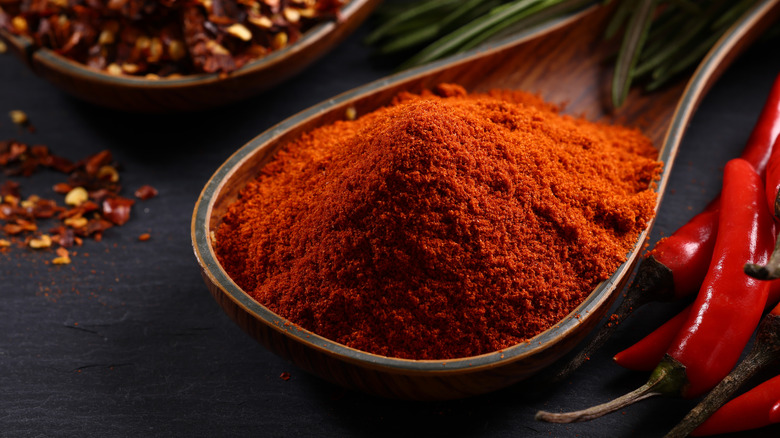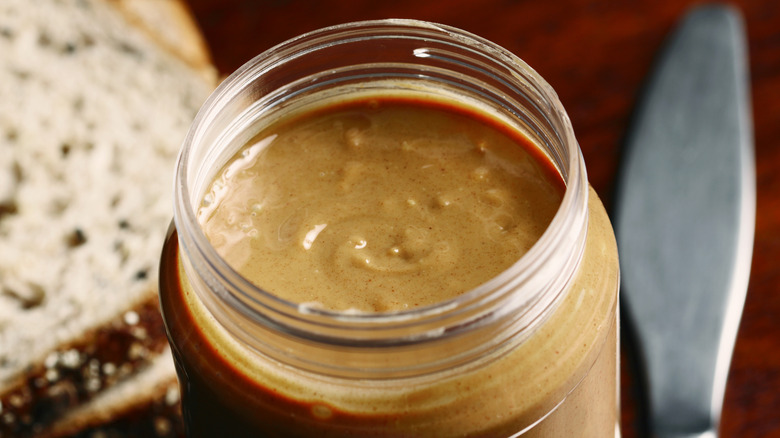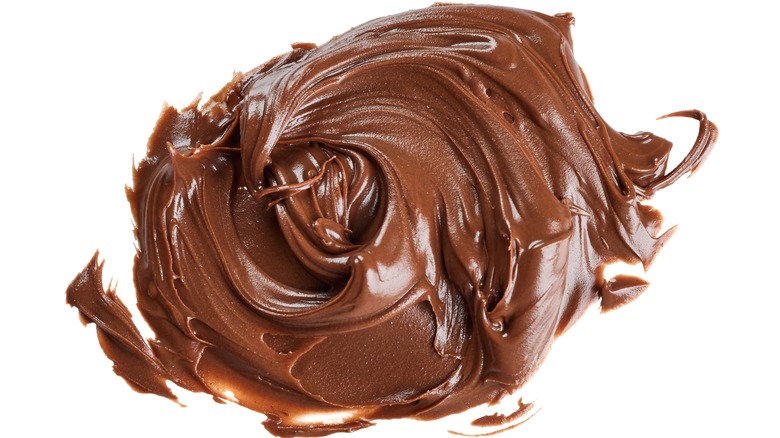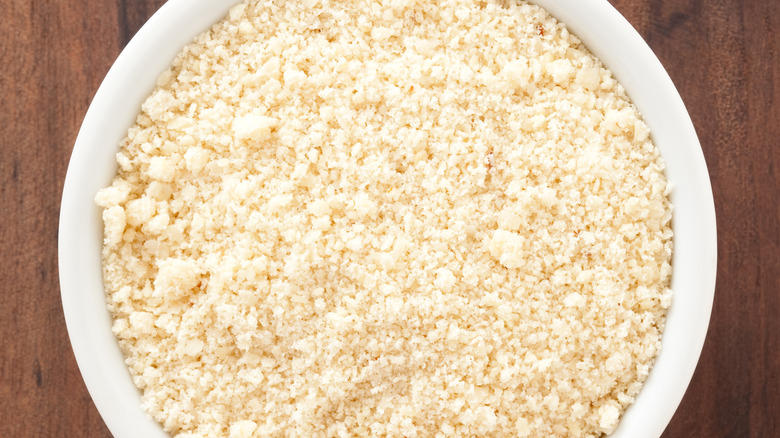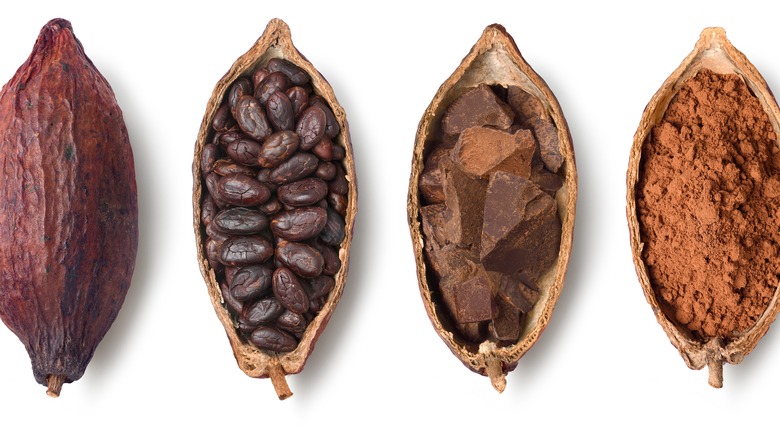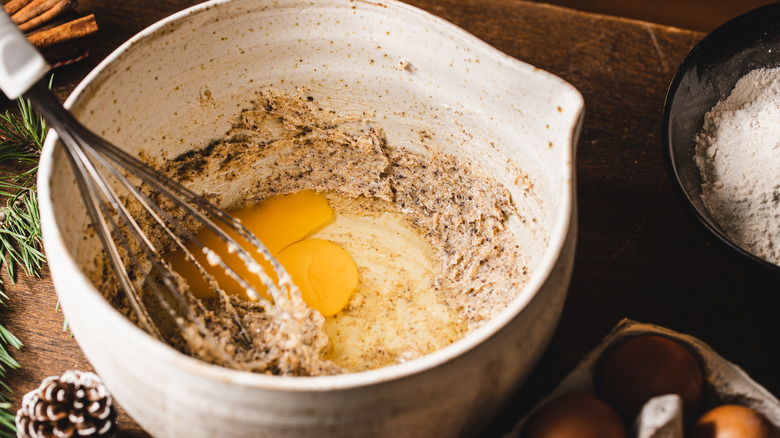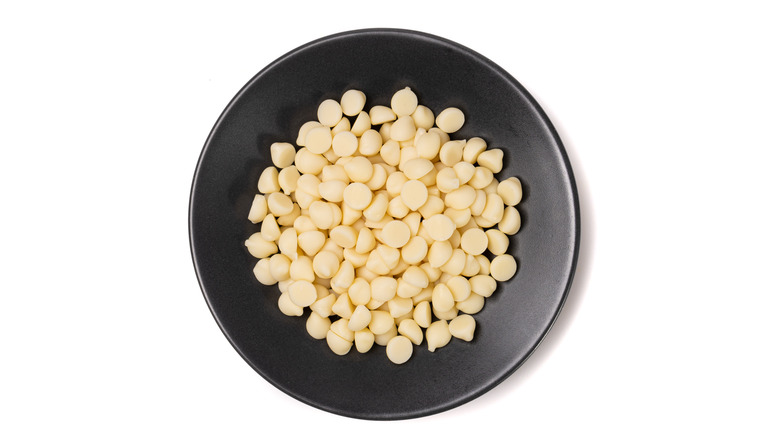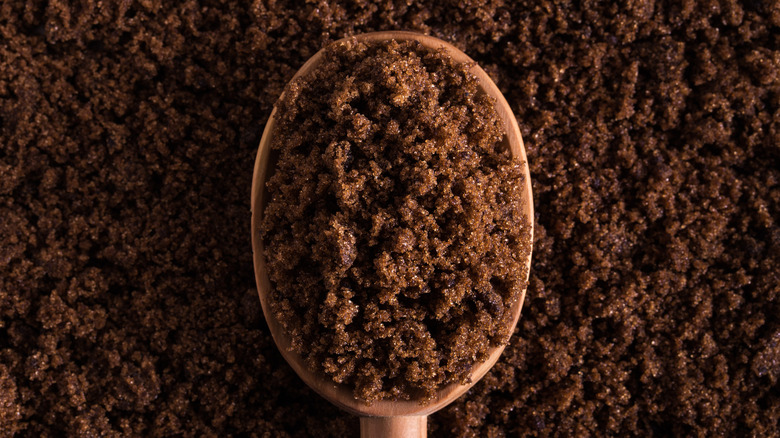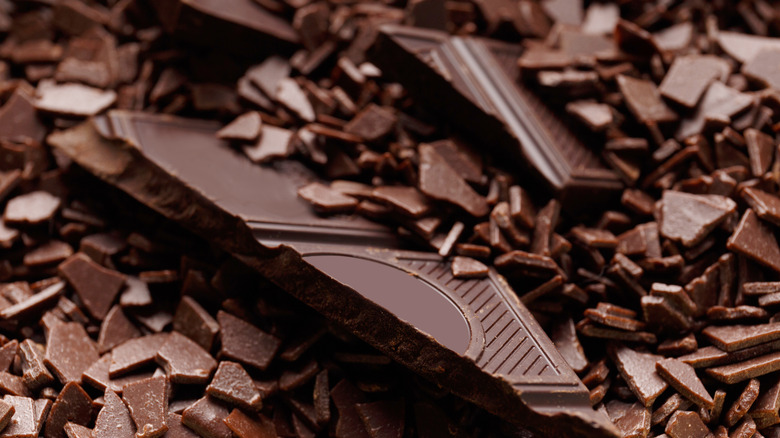Add These Ingredients To Your Brownies And You'll Never Go Back
Undoubtedly, the brownie has etched its place as one of America's most cherished desserts. The digital realm is flooded with a myriad of interpretations, with literally thousands of variations on the classic design. The brownie, in all its fudgy glory, has become a canvas for culinary creativity, sparking countless theories on the best way to achieve that perfect square of fudgy indulgence.
The origin of the name is the subject of much debate, but regardless of where it came from, its birthdate is at least known. In 1893, on the eve of the Columbian Exposition World's Fair, Bertha Palmer — wife of the owner of the Palmer House Hotel in Chicago — dropped into the kitchen; she wanted something compact enough to fit inside the lunch boxes of her attending women's group. After some tinkering, the kitchen staff created the world's first brownie.
Once it was let loose into the world, the search for the perfect brownie continued apace. Listed below are the fruits of all those years of experimentation — your guide to making the perfect brownie.
Coffee
The perfect brownie contains a delicate balance of contradictions. It should be fudgy yet moist, airy yet dense, rich yet subtle. The batter should be light, the crumb soft and pliable, but the surface must maintain a satisfying crunch. Each mouthful needs a little bite, a slight chew that brings with it those warm fuzzies that lie at the heart of most comfort foods. Creating the perfect brownie is a journey, not a destination.
Thankfully, we can take things one step at a time, starting with the basics of a good recipe. When most people think of combining chocolate and coffee, their minds naturally flex towards the familiar taste of a freshly brewed mocha. In baking, that reality couldn't be further from the truth. A coffee-laced brownie is a thing of beauty.
The trick lies in the amount of coffee added. Add too much, and yes, your brownie is going to taste like a cappuccino. But a dash of espresso brings new dimensions of complexity. Finally, remember to add a little extra flour to even things out when adding a shot of espresso.
Pastry flour
Poets might wax lyrical about the melt-in-the-mouth splendor of a perfectly baked brownie, But it won't change one simple truth: The brownie is just a cake, right? Wrong. Although brownies share many properties with cakes, the differences are profound enough to require a shift in vocabulary. The absence of leavening agents, the ratio of chocolate to batter, make them a type of cookie. Still, they begin their life as a cake batter, which means that the usual suspects are on display: sugar, eggs, butter, and – gluten-free variations aside — flour.
There are as many types of flour as brownie recipes, but most pantries contain at least one of three varieties: all-purpose, self-rising, or bread flour. Specialty flours — such as 00 flour for making pasta or strong flour for bagels and pretzels — have their uses, but brownies require a delicate touch. While many recipes suggest using all-purpose flour, it's important to note that superior options are available.
Although cake flour's low protein content helps keep the crumb moist and springy, when applied to brownies, it creates an unsurprisingly cakey brownie. On the other hand, the high protein levels found in pastry flour lend brownies a noticeable — and highly desirable — chew.
Chilli
Choosing the suitable flour allows you to control the texture and body of confectionery, but such timbre is of little use without an associated flavor profile. Sugar imparts sweetness, a pinch of salt mutes bitter notes, and a dash of coffee adds depth, sure, but ultimately, the brownie is best served by its natural prefix: chocolate. The kind of chocolate you use is paramount (more on that later), but its use as a base note provides clues as to what other ingredients might help add an exciting twist to more traditional approaches.
The Mayans consumed chocolate as a drink. A blend of crushed cacao, chili, and cornmeal was sometimes sweetened with honey, laced with herbs, and served hot. Variations of this drink still exist today; Mexican cuisine does not shy away from the tradition; throwing a few squares of dark chocolate into a homemade mole adds the kind of flavor bomb that has people coming back for seconds.
Chili powder, used in moderation, has a similar effect to some of the other ingredients on this list. It enhances the natural aroma of the chocolate without overwhelming it, allowing the palate to detect hidden intricacy. Moderation is of critical importance. A dash of Tabasco or a pinch of chili might take the fruits of your labor to the next level; an unrestrained Scoville bomb would probably have the opposite effect.
Peanut butter
The humble peanut is one of the most versatile, popular foods on the planet. It's also most people's go-to nut (or would be if it weren't for the fact that the peanut is, in fact, a pea). Pedantry aside, 27% of all menus in America feature peanuts in some form, and peanut butter consumption hit an all-time per capita high of 4.4 pounds in 2023.
It's no secret that peanut butter pairs well with chocolate and even less of a secret that peanut butter brownies are very much a thing. But what about adding smaller quantities to complement the overall flavor, as we did with coffee? Peanuts are high in fat; nearly half of every peanut you pop in your mouth is pure fat (although, thankfully, it's mainly of the unsaturated persuasion).
Adding peanut butter in any quantity means adding fat. And too much of that imparts an unpleasant, greasy texture that is best avoided. When baking, messing with ratios is never a good idea, but thankfully, options abound. You can remove up to twice that amount of butter or oil for the amount of peanut butter you add. The more oil you replace with peanut butter, the lighter the brownie will feel. However, a 1-1 substitution adds copious amounts of highly desirable fudgy chew, so a little trial and error is to be encouraged.
Nutella
Nutella has long been nipping at the heels of peanut butter for the title of best spread ever. It began life in post-war Europe, where a scarcity of cocoa forced Italian confectioners Pietro and Giovanni Ferrero to start thinking outside the box. Their paste, made from hazelnuts, sugar, and just a hint of the hard-to-source cocoa, began life as a sliceable, semi-soft loaf. In 1951, SuperCrema — a more spreadable form of the original recipe — hit the shelves. However, it wasn't until 1964 that Ferrero perfected the recipe, and Nutella, as we know it today, was born.
The idea of adding Nutella to brownies was as inevitable as the tides; they do, after all, share similar qualities. Sweet, gooey, and delicious to a fault, a good brownie batter resembles Nutella in more ways than one. Indeed, they are so closely aligned that it is possible to make a Nutella brownie using just two other ingredients: flour and eggs.
Still, for those committed to creating a traditional brownie, a dollop of Nutella certainly brings something to the table. As with peanut butter, ratios are essential here; Nutella is very high in sugar. When adding it to a recipe, substituting the nutty chocolate spread for sugar on a one-to-one basis gifts you with velvet-soft brownies sure to melt hearts and minds alike.
Almond flour
The popularity of almond flour — not to be confused with almond meal — is on the rise, and it's easy to see why. It's naturally gluten-free, as versatile as all-purpose flour, and — if used correctly — adds texture and complexity to dishes. Handy as an alternative to flour in everything from crackers to donuts, it's little wonder that people have been experimenting with almond flour brownies for some time.
Once again, ratios determine when and how to modify a brownie recipe to incorporate almond flour. Like peanuts, almonds are high in fat, and milling does not remove any of it. This is great news if you want to produce a fluffier cake since fat prevents dry ingredients from absorbing too much water. But it is not so fantastic for your brownie, which is already laden with fat from other sources.
Substituting almond flour for all-purpose flour is fine, but since the extra fat thickens the batter, you'll need commensurably more liquid to compensate. Adding a little almond milk helps thin the mixture if you're going for vegan brownies. If not, a splash of regular milk does the trick quite nicely.
Using a blend of regular and almond flour removes the gluten-free badge from the equation but opens up several exciting possibilities. Nutrient-rich and flavorful, it can make for an exceptionally moist experience that often proves hard to resist.
Dutch-processed cocoa
The truth is that chocolate really does grow on trees. The chocolate tree — or, to give it its Latin name, Theobroma cacao — is native to the Amazon rainforest. The Aztecs and Mayans cultivated the plant, and by the time Columbus arrived in 1492, it could be found all over Central America.
The beans themselves require extensive processing. Cocoa beans are left to ferment for a few days, dried, roasted, and finally ground into three products: cocoa mass, butter, and powder. Blending the first two items with milk and sugar produces the chocolate we all know and love. The raw cocoa, however, has a separate journey to take.
Because not all cocoa is created equal, Dutch-processed cocoa, for instance, plays a unique role in the world of chocolate. It undergoes a special treatment that neutralizes its acidity, offering two distinct benefits. First, it doesn't react with baking soda — a boon for brownies since you don't want them to over-rise. Second, it provides a milder flavor, characterized by rich earthy tones, that starkly contrasts the raw cocoa's high acidity and bitter taste.
Air
Brownies require little leavening, but that doesn't mean you won't want to incorporate as much air as possible. With so many variables at play – many of which are actively competing against one another – there are two main pitfalls you need to avoid when making brownies. First, you don't want to create anything that too closely resembles a cake. For the most part, choosing the right cocoa takes care of this issue, but it helps little with the other commonly encountered brownie mishaps. That dreaded overly dense brick of chalky fudge.
While some recipes add baking soda to combat the brownie's tendency to settle into a not-at-all-light state, this option is not always ideal. Alternative ingredients such as almond flour — like Dutch-processed cocoa — do not react well with baking soda.
The solution is to work the egg and sugar mixture together until it hits the ribbon stage, that point of volume where things look like they might collapse at any moment. It's a delicate dance, to be sure. Once achieved, gently folding in the dry ingredients completes the process and — with practice — produces brownies that are both light and delicious.
White chocolate chips
Brownies are difficult to master. They can come out of the oven a little too gooey or not gooey enough; they can overrise and over crumble, and flat brownies are so ubiquitous that they should have their own chapter in the big book of "What Went Wrong in the Kitchen."
Such flaws result from human error, the consequence of perfectly understandable kitchen snafu. The intrinsic chocolatey goodness of a brownie, however, surely is beyond reproach. In the culinary world, the term rich is filled with ambiguity; it is at once something to strive for and something that should be taken in moderation. All that carefully selected cocoa, splashes of espresso, and Nutella dollops do wonders for your brownie's flavor profile. But sometimes, they mess with the balance.
Adding white chocolate chips is just the thing for those who prefer a lighter brownie. White chocolate contains no cocoa solids, so there's no fear of doubling down on in-situ flavors. It also often includes a hint of vanilla, which brings a fragrance that combats the earthier notes familiar to most brownies. White chocolate can be added as chips or melted and swirled into the batter.
Muscovado sugar
There are as many types of sugar as variations on the basic brownie recipe, and choosing the correct type is crucial. While the regular granulated kind can get the job done, if you're aiming for a truly exceptional brownie, you need to consider the unique qualities of muscovado. This unrefined sugar carries a distinct caramel flavor profile that can elevate your brownies to the next level.
Okay, so what exactly is muscovado sugar? All manufactured sugar begins life as one of two plants: sugar cane or sugar beets. After harvesting, the liquid is extracted from cane and beets and boiled until crystals form within a sticky syrup known as molasses. The sugar is then processed, and this process defines the properties of the sugar you buy.
Muscovado receives minimal processing, and its high molasses content creates a dark, sticky sugar perfect for baking. Used in everything from barbecue sauce to cookies when added to brownies it brings body, complexity, and depth to the final product.
Bars of chocolate
So, we've used high-quality Dutch-processed cocoa, and yes, it brings a rich chocolate warmth to an already irresistible treat. But the brownie isn't any old treat. What is probably a surprise to nobody is that the last not-so-secret ingredient to appear on this list is, in fact, chocolate itself.
Tearing apart a bar and swirling squares of melted chocolate into the batter just before baking does to brownies what world-class conducting does for an orchestra. Not only does it double down on the intrinsic hard-to-define chocolatey goodness of the finished product, but it also brings those aspirational adjectives that every home baker secretly craves: gooey, fudgy, moreish.
Instincts might work against you here, and the temptation to reach for a familiar and easy-to-digest milk chocolate is understandable. Brownies, however, are sweet enough as they are, and a bar of semi-sweet dark chocolate adds all the flavors and textures you could ask for without damaging the delicate balance you've worked so hard to impart. Which chocolate to use is a matter of personal taste and is subject to much online debate; however, dark chocolate containing at least 60% cocoa solids seems to be a sweet spot.
